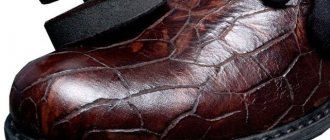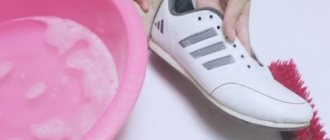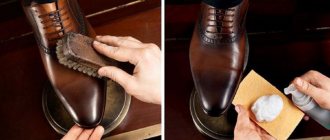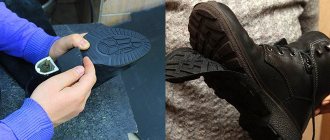Autumn and winter often become a real test of strength for boots and boots. Snow and puddles saturate them with moisture, leaving salt streaks. And the reagents scattered for the safety of pedestrians only aggravate the situation. Therefore, it is important to properly clean shoes from salt and protect them from adverse external influences.
Professional remedies against salt on shoes
You can remove salt from shoes using professional cleaning products:
- Detach Stain is a product that neutralizes salt stains from shoes made of any materials thanks to the vinegar in its composition. Apply to a sponge and apply to the stain. After a couple of minutes, wipe the treated area with a damp cloth, and after drying, lubricate it with protective cream.
- Tarrago De Salter is a handy pocket-sized solution against salt on leather and suede shoes. Contains fluorine. Before applying, shake the can, turn it down with a sponge, and treat the stained area. After a few minutes, wipe off the foam with a damp sponge.
- "Antisol" from Salton. Removes salt from smooth leather, nubuck and suede products. Consists of a complex of natural organic acids. Shake the can, apply the product to the shoes using a spray bottle, and immediately wipe off the salt stains (no need to wait until the composition dries). Lubricate the treated area with cream.
- “Water-repellent impregnation” from Salamander for textile, suede shoes, nubuck, velor, smooth leather, TEX membrane. The product contains fluoride. Apply to the dried, clean surface of the shoe at a distance of 20 cm, leave until completely dry.
These products will not only get rid of salt stains on shoes, but will also prevent their further occurrence.
Removing salt stains depending on the material
You can wash salt from shoes using either chemicals or homemade recipes only after determining the material from which the shoes are made. Leather, suede and nubuck have their own characteristics and processing rules.
Leather
Products made from natural materials are more difficult to clean, but get dirty more easily. Genuine leather has a porous structure, so salt settles on it quickly and for a long time. It must be washed immediately: wipe the boots with damp towels, then wrap them in napkins and leave to dry.
Vinegar essence helps remove salt from both natural and artificial leather shoes: you need to dilute the vinegar with water in a ratio of 1:4, then soak a cotton swab in the solution and treat the stains. At the end of the procedure, you need to wipe the boots with a damp cloth and let them dry.
Attention! Before applying the vinegar solution to the outside of the product, you need to check the reaction on the inside. If the material has not changed its structure and color, then the product can be considered harmless.
Suede
Since it is quite difficult to clean white salt stains on suede shoes due to the capricious material, stains should be removed as they appear.
We recommend:
How to stretch jeans at home
First of all, the surface is moistened with steam: a steam generator or a pan of boiling water is suitable for this. You should not wet suede boots under a tap, as the material may deteriorate. When steaming, do not hold shoes too close to the source, otherwise the seams may unravel.
If white spots appear, you need to take baking soda or tooth powder - they are poured onto the stain and left for a while. Once the ingredients have absorbed the salt, the powder can be removed using a soft brush.
Nubuck
A solution of laundry soap is suitable for this material - you need to wipe the stains with a soapy cloth, and then wipe off the product with a clean napkin.
Potato juice also helps: the starch neutralizes the salt, making it easy to remove after drying.
Leatherette
Artificial leather is more resistant to salt stains compared to natural leather. To remove salt, you can use medical alcohol or vodka: moisten a cotton swab and walk along the line of contamination. Then the boots are wiped with a damp cloth and dried.
Effective home remedies for leather shoes
Leather products are most susceptible to salt stains. Reagents accumulate in the seams, on the surface of the boots, and corrode the material from the inside. Professional and home remedies work well for cleaning.
Castor oil
Many people do not know how to remove salt from shoes after a walk. Castor oil is suitable for this purpose. Soak a cotton pad in it and gently wipe the contaminated areas after the shoes have dried. If after the first treatment white stains remain, the procedure is repeated. Old stains will have to be lubricated daily for a week.
You cannot use sunflower oil or any other oil instead of castor oil, as they can make your boots look untidy.
There is another recipe against salt stains on leather products. Mix castor oil (1 part) with fish oil (3 parts), place in a water bath until the fat dissolves. Apply the slightly cooled mixture onto the stains, leave for a couple of hours, and remove with a sponge soaked in water.
Vinegar
You can clean stains from reagents on shoes using vinegar essence (9%). 1 tsp. mix water with 3 tsp. vinegar. Wet a sponge in the resulting solution and wipe the contaminated surface. Then we dry the shoes, after half an hour we apply shoe polish to them. Re-processing may be required.
Aggressive solvents (gasoline, acetone, white spirit) cannot be used to treat shoes, as the paint may peel off.
Alcohol
It can also be used to remove salt stains from genuine leather products. Soak a piece of rag in alcohol and wipe the shoes along the stain line. To consolidate the result, we repeat the procedure.
Method one - vinegar
To do this you will need a small amount of wine vinegar. Dilute 3 tablespoons of vinegar in one spoon of water. Use a special brush to remove dirt from your boots. Using a cotton swab or soft cloth, thoroughly wipe the leather part of the boot and leave for 10 minutes. Afterwards, remove the remaining unabsorbed solution with a damp cloth.
How to get rid of salt on suede shoes
Suede products require delicate care. To remove reagent residues from them, it is better to use professional means, but if you don’t have any at hand, effective folk methods will do.
Ammonia
Old stains can be removed with 1 tsp. soda, 2 drops of ammonia solution, 100 ml of milk. Soak a soft cloth in the solution and wipe the boots. Then use a damp cotton pad to remove the remaining solution along with the reagents.
Steam
Steam baths will help remove salt from shoes. To do this, boil water in a large container and place boots over the steam. They must be held so that the surface of the boots is slightly damp, since due to a large amount of water the material will harden and lose its shape. After such a steam bath, the remaining salt can be easily removed with a regular brush.
Potato
You can remove salt from shoes using raw potatoes, peeled and cut into two parts. We rub the stains with a cut of the tuber, leave until completely dry, and remove the remaining reagents with a brush for suede products.
The crumb of white or black bread has a similar effect.
Dentifrice
Helps quickly remove salt stains from autumn and winter suede boots. It is enough to evenly distribute the powder on contaminated areas. Within half an hour, the substance should absorb the salt.
Then the boots are cleaned with a brush or vacuumed.
Shoe protection
To protect different types of shoes from salt, many ready-made products have been invented in various forms: liquid, cream or spray. Don't forget to treat your boots with them before going outside. This will help the shoes and make it easier to deal with salt stains. You can also use home remedies:
soak a sponge in hair conditioner and wipe leather shoes. Allow the product to absorb; moisten a rag in vegetable oil and rub it into the leather of the shoes. The fat base will prevent the formation of streaks; wax is an excellent means of protection. Soften it and rub the shoes, then treat with a brush; melt the wax, pour in turpentine and castor oil. Apply the ointment to your boots thoroughly.
How to remove salt from nubuck shoes
This material does not like water, so using it in large quantities for cleaning is not recommended. After a walk, nubuck boots should be thoroughly dried, then walked over their surface with a special brush with rubber bristles. You need to comb your shoes in different directions to avoid the lint sticking together. You can also use a regular or shoe eraser.
A soap solution in which a sponge is moistened and the stained areas are wiped will help get rid of any remaining reagents. The boots are dried in a warm room. Vinegar solution (1 tsp of essence per glass of water) removes traces of salt well.
It is better to remove salt stains from nubuck shoes point by point, applying cleaning products only to the stains.
Other spots
Sometimes boots lose their attractiveness not only from salt, but also from other stains that may appear on them.
There are several universal methods that help remove fairly difficult stains.
- Green grass will be washed with a low concentration saline solution.
- Flower stains can be removed with a cotton wool soaked in gasoline. The cleaned area should then be blotted with a cotton pad soaked in ammonia. When the area is dry, sprinkle the surface with baby talcum powder.
- Red tomatoes are produced by the same tomatoes, only green.
- Potato starch will remove medicinal iodine stains.
- The candle wax should be carefully scraped off the surface and the resulting stains should be moistened with gasoline.
- We clean the blood with running water, and then treat the surface with a soap solution.
- Chewing gum should be frozen first. To do this, pack the shoes in a plastic bag and place them in the freezer for several hours. If a mark remains, wipe the surface with gasoline.
Gasoline is an effective remedy, but it has a sharp, unpleasant odor. The smell of gasoline will be removed by soap solution and ammonia.
Another negative property of suede shoes is that, regardless of the degree and thoroughness of care, over time they begin to become shiny. To remove this unsightly shine, rub the surface with a regular school eraser. Treatment with ammonia and sandpaper will also help. The latter will invigorate the suede fibers, the shoes will become like new.
Helpful tips for cleaning at home
Many people are interested in how to remove salt from shoes without harming them. Several rules must be followed:
- You should clean your shoes immediately upon arriving home. First, wipe them with a damp cloth or sponge. It is necessary to rinse the cloth frequently so as not to smear the salt.
- Particular attention is paid to the seams, since this is where the maximum salt accumulates. The seams can be scrubbed with a brush.
- Then you need to wrap the product in dry material or paper napkins so that excess moisture and salt are absorbed.
- Leave the shoes like this to dry. You can place it near the battery, but not close, but at a distance of 30-50 cm, so that the surface of the product does not deteriorate. In a couple of hours, all moisture should evaporate.
- After the boots have dried, they are inspected. If salt stains remain on them, you need to clean them using professional or folk remedies.
- Then the products are lubricated with a water-repellent compound or cream. You need to wait until it is absorbed and wipe the surface with a dry cloth.
- Suede shoes are cleaned with napkins and soap foam. It is also suitable for washing dirty shoe bases.
Paper and baby cream
To properly use such an unusual tandem, you need to apply a simple operating algorithm:
- When you leave the street, immediately rinse your shoes with lukewarm water.
- Wrap salted areas in paper or paper napkins.
- Leave this pair for a while.
- During the drying process, salt from the surface of the shoe will be absorbed into the paper.
- Treat dry shoes with baby cream. It will protect it from external factors (including salt absorption) and polish it.
What to do to prevent salt stains from appearing
The appearance of salt stains can be avoided if you follow the rules for caring for shoes:
- Boots must be treated with special water-repellent agents (Salamander, Kiwi, TJ Collection), just do this in advance so that they have time to dry. Colorless wax is also suitable, which protects shoes well from dirt, moisture and reagents.
- On frosty days, it is better not to use silicone sponges and brushes. Silicone freezes, which can damage the material of the product. Reagents that get into microcracks are very difficult to remove from them.
- After each trip outside, be sure to wash leather boots with warm water, and clean suede boots with a brush.
- If salt remains on the surface of the shoes, special shoe paint can paint over the stains.
- You should not wear boots that are not yet completely dry, as reagents stick to a wet surface much faster. You can speed up the drying process by using a brush, which will remove excess moisture. A fireplace, radiators or fan should not be used to dry items faster.
On the street, you must try to avoid the dirty mess that consists of ice, snow and reagents. As a last resort, it is better to carefully walk through the puddle. In winter, give preference to shoes with thick soles or platforms so that less salt gets on the surface of the boots. It is better to wear suede products only at sub-zero temperatures.










